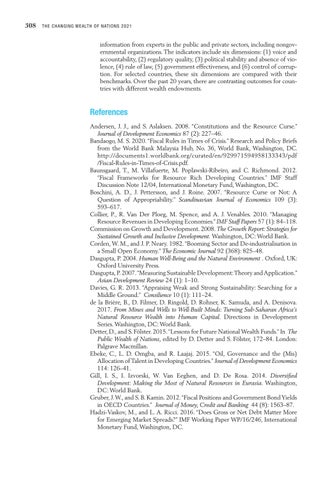308
T H E C H A N G I N G W E A LTH O F N ATIO N S 2021
information from experts in the public and private sectors, including nongovernmental organizations. The indicators include six dimensions: (1) voice and accountability, (2) regulatory quality, (3) political stability and absence of violence, (4) rule of law, (5) government effectiveness, and (6) control of corruption. For selected countries, these six dimensions are compared with their benchmarks. Over the past 20 years, there are contrasting outcomes for countries with different wealth endowments.
References Andersen, J. J., and S. Aslaksen. 2008. “Constitutions and the Resource Curse.” Journal of Development Economics 87 (2): 227–46. Bandaogo, M. S. 2020. “Fiscal Rules in Times of Crisis.” Research and Policy Briefs from the World Bank Malaysia Hub, No. 36, World Bank, Washington, DC. http://documents1.worldbank.org/curated/en/929971594958133343/pdf /Fiscal-Rules-in-Times-of-Crisis.pdf. Baunsgaard, T., M. Villafuerte, M. Poplawski-Ribeiro, and C. Richmond. 2012. “Fiscal Frameworks for Resource Rich Developing Countries.” IMF Staff Discussion Note 12/04, International Monetary Fund, Washington, DC. Boschini, A. D., J. Pettersson, and J. Roine. 2007. “Resource Curse or Not: A Question of Appropriability.” Scandinavian Journal of Economics 109 (3): 593–617. Collier, P., R. Van Der Ploeg, M. Spence, and A. J. Venables. 2010. “Managing Resource Revenues in Developing Economies.” IMF Staff Papers 57 (1): 84–118. Commission on Growth and Development. 2008. The Growth Report: Strategies for Sustained Growth and Inclusive Development. Washington, DC: World Bank. Corden, W. M., and J. P. Neary. 1982. “Booming Sector and De-industrialisation in a Small Open Economy.” The Economic Journal 92 (368): 825–48. Dasgupta, P. 2004. Human Well-Being and the Natural Environment . Oxford, UK: Oxford University Press. Dasgupta, P. 2007. “Measuring Sustainable Development: Theory and Application.” Asian Development Review 24 (1): 1–10. Davies, G. R. 2013. “Appraising Weak and Strong Sustainability: Searching for a Middle Ground.” Consilience 10 (1): 111–24. de la Brière, B., D. Filmer, D. Ringold, D. Rohner, K. Samuda, and A. Denisova. 2017. From Mines and Wells to Well-Built Minds: Turning Sub-Saharan Africa’s Natural Resource Wealth into Human Capital. Directions in Development Series. Washington, DC: World Bank. Detter, D., and S. Fölster. 2015. “Lessons for Future National Wealth Funds.” In The Public Wealth of Nations, edited by D. Detter and S. Fölster, 172–84. London: Palgrave Macmillan. Ebeke, C., L. D. Omgba, and R. Laajaj. 2015. “Oil, Governance and the (Mis) Allocation of Talent in Developing Countries.” Journal of Development Economics 114: 126–41. Gill, I. S., I. Izvorski, W. Van Eeghen, and D. De Rosa. 2014. Diversified Development: Making the Most of Natural Resources in Eurasia. Washington, DC: World Bank. Gruber, J. W., and S. B. Kamin. 2012. “Fiscal Positions and Government Bond Yields in OECD Countries.” Journal of Money, Credit and Banking 44 (8): 1563–87. Hadzi-Vaskov, M., and L. A. Ricci. 2016. “Does Gross or Net Debt Matter More for Emerging Market Spreads?” IMF Working Paper WP/16/246, International Monetary Fund, Washington, DC.


